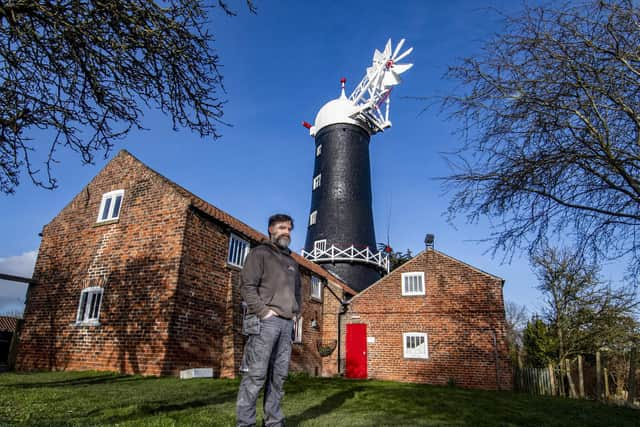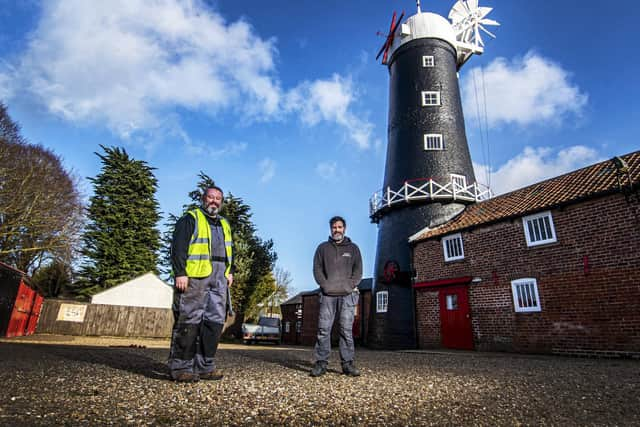200-year-old Skidby Mill - one of only two working mills left in Yorkshire - to undergo restoration
Then Skidby Mill will be transformed into a rumbling “living, breathing machine”, capable of harnessing the power of the wind and grinding grain into flour again.
Skidby is one of only two working windmills left in Yorkshire – the other is Holgate Windmill, in York. And the band of craftsmen who tend to them is getting ever smaller, to the point where millwrighting is recognised as a critically endangered craft.
Advertisement
Hide AdAdvertisement
Hide AdThis week a crane lifted the fans back on, which keep its four massive 11-metre sails into the wind.


The sails have also been sent away for restoration but should return later this year – a momentous year for the much-loved local landmark as it is its 200th anniversary.
Millwright Jon McGuinness, who fitted the fans back on Wednesday, got hooked on windmills at the age of four when he visited North Leverton windmill, in Nottinghamshire, on a school trip and saw its huge sails turning.
He dragged his parents back and ended up going there every Saturday to learn from miller Bill Heathershaw.
Advertisement
Hide AdAdvertisement
Hide AdAfter taking a detour into farming, in 2008 he returned to find Mr Heathershaw had died and the mill “desperate” for repairs. He and a team of volunteers, farmers and landowners got it reopened.


Millwrighting, he says, is a “dying” craft, although there are a few young people interested in learning the numerous skills involved.
Mr McGuinness said: “It’s an endangered rural craft – it’s been red-flagged by the Society for the Protection of Ancient Buildings, Historic England and the National Trust. It’s not just the amount of machinery, it’s being able to recog a wheel, dress the millstones to get them to grind properly.
“You can’t go to B&Q for anything for a windmill as everything is handmade.”
Advertisement
Hide AdAdvertisement
Hide AdLockdown fired people’s enthusiasm for baking and when the shelves were stripped bare during panic buying people turned to traditional millers. Mr McGuinness said: “It ticks a lot of boxes, It’s renewable energy, very hands on and it produces healthy stone-ground wholefood.
"A windmill doesn’t cost a penny to run when it’s going – keeping them going is the expensive part. The council is doing the right thing by spending the money on it. Times are hard but they’ve found the cash to keep it looking pristine.”
The fans were restored by the country’s last traditionally trained millwright Steve Boulton, who has looked after maintenance and renovation work at Skidby for more than three decades.
He served his apprenticeship with R Thompson & Sons of Alford, Lincolnshire, founded in 1877, and when he started there were “six blokes under you and you moved up the pecking order as one left”.
Advertisement
Hide AdAdvertisement
Hide AdHe said: “Those companies don’t exist any more – these days it is pretty much one-man bands. When I started I was told you had to be a joiner, bricklayer, stonemason, engineer, welder, but most of all a problem solver.
“It is now getting to the stage where there’s not many millwrights left, and people are starting to worry about the future. But they’ve almost left it too late. I haven’t anyone to pass my skills and knowledge onto,” Mr Boulton said.
Skidby Mill’s owner East Riding Council is preparing a display looking at events in the mill’s history over the past 200 years and telling the stories of some of the people who worked there.
It will go online from May 4, and subject to staff availability, the physical display will be in the mill and open to the public from May 17.
Advertisement
Hide AdAdvertisement
Hide AdA decision, however, hasn’t yet been made on whether flour will again be milled at Skidby.
A council spokesperson said: “We are happy to explore the possibility of restoring the milling of flour at Skidby Mill, but we would need to consider the merits of doing so very carefully, to ensure that it could be restarted on a sustainable basis.”
Comment Guidelines
National World encourages reader discussion on our stories. User feedback, insights and back-and-forth exchanges add a rich layer of context to reporting. Please review our Community Guidelines before commenting.